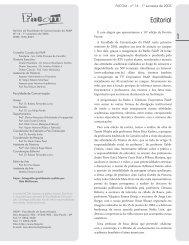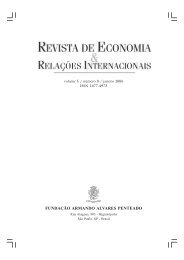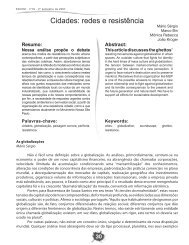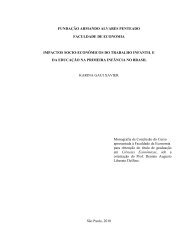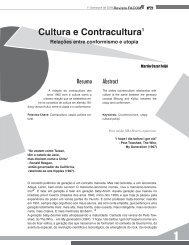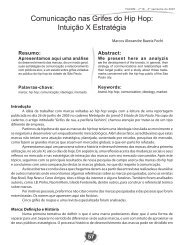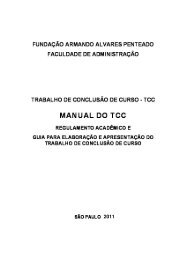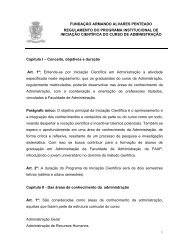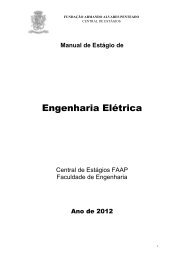GUIA DE ESTUDOS / STUDY GUIDE / GUIA DE ESTUDIOS - Faap
GUIA DE ESTUDOS / STUDY GUIDE / GUIA DE ESTUDIOS - Faap
GUIA DE ESTUDOS / STUDY GUIDE / GUIA DE ESTUDIOS - Faap
You also want an ePaper? Increase the reach of your titles
YUMPU automatically turns print PDFs into web optimized ePapers that Google loves.
Guia de Estudos / Study Guide / Guia de Estudios<br />
New Zealand’s Allegations<br />
AS TO THE NUCLEAR TESTS<br />
New Zealand’s department of Health, together with<br />
the Meteorological Service of the Australian Radiation<br />
Laboratory, have the most intense monitoring program<br />
for nuclear testing of the Pacific region. Many measurements<br />
were taken and they show that radioactive material<br />
has swept west to the central South Pacific.<br />
First of all it is prompt to notice that by doing atmospheric<br />
tests, France violated the Nuclear Test Ban Treaty<br />
of 1963 (Signed on August 5, (182 signatories and 155<br />
ratifies) 17 was the result of a hard negotiation between<br />
the United States, the United Kingdom, Canada, France,<br />
and the Soviet Union to began on the ending of nuclear<br />
weapons testing, mediated by the United Nations Disarmament<br />
Commission. This treaty pursued all diplomatic<br />
efforts for a test ban treaty before resuming underground<br />
testing. The test ban was a first step to nuclear<br />
disarmament 18 and even countries such as New Zealand<br />
and U.S.A. refusing to help France with that type of tests<br />
France has managed, using different national airlines, to<br />
staff the test sites to its own satisfaction.<br />
Because of the submission made by New Zealand and<br />
Australia, the atmospheric tests made by France, were<br />
prohibited by the ICJ. Some of the environmental effects<br />
that those tests caused were the remains in the<br />
atmosphere, on the ground, and in water bodies of<br />
about one half of the cesium and strontium.<br />
Some of the environmental effects of the underground<br />
tests made by France at Moruroa atoll were divided in<br />
short term: fracturing of the atoll surface triggers landslides,<br />
tsunamis (tidal waves), earthquakes and radio<br />
nuclides vented to the environment and long term effects:<br />
leakage of fission products to the biosphere, fish<br />
poisoning and transfer of dissolved plutonium from<br />
the lagoon to the ocean and the food chain. 19<br />
The winds which circulate in the high-pressured region<br />
of the Tuamotu island group were the reason why the<br />
contaminated water was carried by ocean currents towards<br />
to New Zealand and Australia on a south-southwest<br />
swing, making these effects to affect New Zealand.<br />
Diplomatic protests concerning the French tests were<br />
made by Australia and, New Zealand, in order to prevent<br />
other countries from these dangers.<br />
France has breached the Moscow Test Ban Treaty of<br />
1963 which stated that all atmospheric tests of nuclear<br />
weapons are illegal. This treaty had nearly universal acceptance,<br />
which shows an international consensus in<br />
favor of the principles contained therein. One of the<br />
main importance of the Test-Ban Treaty was the overwhelm<br />
expectation of the world it created about the<br />
unlawfulness of atmospheric nuclear testing.<br />
Therefore, France breached this important treaty when<br />
pursuing atmospheric nuclear tests. From 1966 to<br />
1975, France conducted 41 atmospheric tests in the<br />
Muruoa atoll, located on the French Polynesia. 20<br />
AS TO THE 1986 AGREEMENT<br />
France started to threaten New Zealand’s access to the<br />
European Economic Community market, having New<br />
Zealand’s exports boycotted. As a reaction, New Zealand<br />
started to act in a similar way. Because both countries<br />
were having economical damages, they allowed<br />
the United Nations Secretary General at the time, Mr.<br />
General Javier Pérez de Cuéllar, to mediate a settlement.<br />
Therefore, the 1986 agreement was made in 8 July<br />
1986. It was a binding decision, that France had to pay<br />
NZ$13 million (USD$6.5 million) to New Zealand as a<br />
recognizance of apology. Additionally, France was ordered<br />
not to interfere anymore on New Zealand’s trade<br />
negotiations.<br />
Alain Mafart and Dominique Prieur, both French agents<br />
disguised that acted in the Rainbow Warrior case, were<br />
to serve their sentences, and therefore arrested at the<br />
French military base on Hao atoll, in French Polynesia,<br />
for three years.<br />
However, instead of doing what was agreed, the two<br />
agents returned to France, after less than two years on<br />
the atoll. Alain Marfart returned on 1987 because of “illness”<br />
and Dominique Prieur returned on May 1988 because<br />
she was pregnant. Both of the agents, when arrived<br />
home, were honored, decorated and promoted.<br />
81






